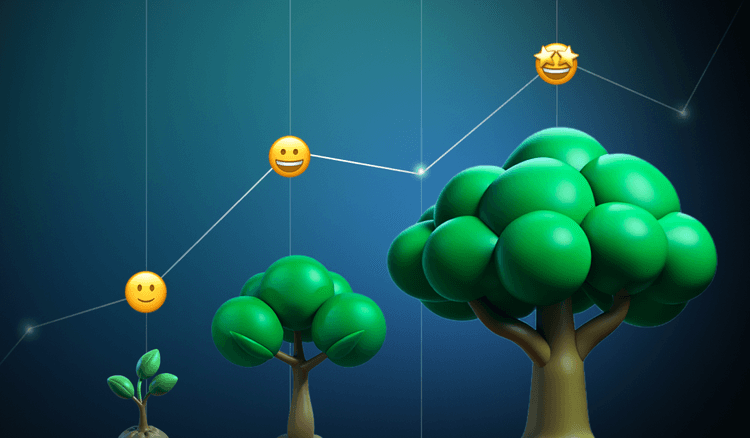Attracting users to your app is only the first step towards achieving commercial success. The journey doesn't end with a download. It's about keeping users retained and fostering enduring relationships over time.
"According to Quettra's statistics, the journey of an average app can be quite challenging.
Within just three days of installation, it experiences a staggering loss of 77% of its daily active users (DAUs). As the days pass, this decline continues relentlessly, with 90% of DAUs vanishing within a month and over 95% disappearing within a span of 90 days.
These numbers serve as a poignant reminder of the fierce competition and fleeting nature of user engagement in the app ecosystem."
Maria Zmachinskaya, CMO at SolveIt
With the substantial costs involved in user acquisition, the importance of retaining them cannot be overstated. In this article, we’ll discuss why mobile app retention is vital for your app's success and unveil reliable strategies to enhance it. Let's delve into the details!
Why is app retention so important?
Revenue generation
Retained users are more likely to make in-app purchases and subscribe to premium features. Such users have already demonstrated a willingness to invest in your app's offerings and tend to continue spending over time.
Plus, retaining existing users can help you cut some expenses. Retaining is typically less costly than acquiring new users and spending a pretty penny on marketing, advertising, and promotions. Thus, user retention helps to save resources and maximize the return on investment.
How much does it cost to develop an app?
Read articleBrand loyalty
By consistently meeting user needs and delivering value, the mobile app provides a sense of loyalty among its user base. Loyal users are more forgiving of occasional bugs, especially when they feel a strong connection to the app.
In addition, satisfied users often engage within the app community, leave positive feedback, and recommend the app to friends and family. Word-of-mouth referrals from loyal users can significantly drive user acquisition efforts and boost the app's reputation in the market.
Iterative improvement
When people spend time within an app, they notice how it evolves and, most importantly, they can share their thoughts on these changes. Their insightful feedback can help you understand user preferences (or pain points) and streamline further enhancements.
Focusing on issues that resonate with the user base not only improves the overall user experience. It makes your team take a more user-centric approach to the mobile app development process.
Mobile app retention rate: statistics
Understanding the dynamics of mobile app retention rates is crucial for developers seeking to create sustainable user experiences. It's worth noting that app retention can vary significantly across different app categories and industries, and even mobile platforms.
According to the Business of Apps research, the average retention rate on Android stands at 22.6% on Day 1 and gradually declines to a mere 2.6% by Day 30. For iOS, these metrics are 25.6% and 4.3% respectively.
When it comes to app categories, mobile app retention rate statistics on iOS and Android platforms show similar leaders. The top three include news, finance/business, and transportation apps.
Do you need a free consultation?
Contact usWhether focusing on iOS or Android app development, providers should carefully tailor their app retention strategies to account for the unique characteristics and user behaviors associated with each platform.
7 Strategies to enhance user retention
In this section, we'll outline practical steps aimed at enhancing app retention, with a particular focus on design and user experience.
Prioritize a good UX
Of course, visual appeal plays a significant role in encouraging users to spend more time in your app. But the real awe-effect is achieved when users can navigate the app without any hesitation. If they can effortlessly find what they need, they're more likely to stick around.
To simplify navigation, make sure that all essential features are easily accessible. For that, make all UX elements (buttons, menus, search bars, etc) clear and intuitive. Collaborating with skilled UI/UX design agencies can help ensure that your app not only looks great but also provides a seamless user experience.
How long does it take to design an app?
Read articleMake sure that those navigation elements meet the following requirements:
-
Clear texts and CTAs: vague wording can confuse users; they should know what to expect after clicking on a button or menu item.
For example, instead of using abstract messages like "Click Here," opt for descriptive phrases like "Sign Up" or "Download Now." -
Placement: navigation elements should be placed where users naturally expect to find them based on common design practices.
-
Categorization in menus: content and features organized into logical groups make it easier for users to locate and access what they need.
-
Feedback: visual response when buttons or menu items are pressed notifies users that their actions have been successful.
This can be achieved through animations, color changes, or subtle effects that indicate the button's state (e.g., pressed or disabled).
If you’re looking for UI/UX design services, make sure that you choose a team able to create a smooth environment where users feel valued.
How to chose mobile app development company?
Read articleProvide flawless onboarding
Statistically, 75% of users abandon an app within the first week if it is difficult to use it. And it can be easily explained: users have countless options in the app marketplace, and if they encounter confusion or frustration, they are quick to move on to more user-friendly alternatives.
As such, providing a smooth intro to the app's features is a great welcoming gesture and a way to skyrocket your app retention rate. Guided tutorials, tooltips, and interactive walkthroughs can help users understand how to accomplish their goals effectively, especially when enhanced by quality front-end development services.
When designing an onboarding experience, make sure to communicate the app's value proposition and benefits to users upfront. Highlight what makes the app unique and why they should continue using it.
Some users may want to refresh their knowledge or explore additional features whenever they desire. Let the onboarding experience remain accessible for users to revisit when needed and feed them regular knowledge with in-app notifications or newsletters, which are a powerful tool whenever used in a way that's talked about on various email marketing podcasts.
Nice to have: In addition to providing onboarding for new users (with the help of a product adoption software), it's equally crucial to implement brief onboarding tips for existing users when new features are introduced. By doing so, users can swiftly grasp the value of the new features and seamlessly incorporate them into their app experience.
Use the power of personalization
Who doesn't love feeling special, right? That’s why personalization is the key to improving mobile app retention. By leveraging user data and preferences, you can tailor the app experience to various groups of users, making it more relevant and compelling.
Whether it's adjusting content, recommending products or services, or simply greeting by name, app personalization adds that warm feeling of being treated like a VIP. And statistics confirm that.
According to Think with Google, a striking 63% of users are willing to make purchases from apps that provide relevant product recommendations, tailored to their interests and preferences.
Remember that the journey of app personalization is a lasting one. Allow users to customize their experience by choosing favorite topics, setting preferences, and more. By giving users a feeling of control over their experience, much like an Instagram user curates their own feed, you deepen their connection to the app.
Use notifications wisely
Effective use of push notifications can significantly impact app retention rate by keeping users informed about relevant updates within the app. However, it's essential to use notifications rationally and avoid bombarding users with irrelevant or excessive messages.
64% of users will completely discontinue using an app if they receive more than five push notifications per week. Instead, focus on delivering timely notifications that provide value.
A delicate balance of how not to overload users with notifications implies a few rules:
-
Opt-in approach: allow users to opt-in to receive notifications rather than automatically enabling them.
-
Relevance: ensure that notifications are timely, relevant, and valuable to users. Personalize notifications based on user behavior, preferences, and location to deliver content that resonates with their interests.
-
Optimal timing: avoid sending notifications during periods when users are likely to be busy or asleep; schedule them for times when users are most likely to engage with them.
Don't overwhelm users with ads
Let's talk about another aspect that needs a gentle touch: advertising. While ads can be a valuable monetization strategy for your app, similar to notifications, it's crucial to strike a balance.
TOP 5 app monetization strategies
Read articleFirst off, think about the timing. Nobody likes to be interrupted in the middle of a task, so consider showing ads during natural breaks in the user experience. For instance, between levels in a game, a common practice in game development, or when scrolling between articles in a news app.
Next, show ads that are actually useful. Instead of random ads, use data and targeting to show users perfectly designed ads of products and services they might be looking for.
Lastly, don't forget about user experience. Make sure ads don't disrupt the flow of the app. If users accidentally tap on ads when navigating through an app, it may irritate them. So opt for strategic ad placement that complements the user journey.
Leverage gamification and rewards
Gamification techniques can be highly effective in driving mobile user retention and engagement. They add elements of fun, competition, and rewards to the app experience. You can incorporate features such as achievements, digital badges, or challenges to motivate users to stay active.
Moreover, consider implementing reward systems that offer tangible benefits or incentives for user participation. Rewards can take various forms: virtual currency, exclusive content, discounts, or in-app perks. Gamification in loyalty programmes can make these rewards more engaging, keeping users motivated to return and participate.
The good news is that it’s possible to implement gamification and rewards almost in any tech startup idea – from entertainment to finance. But keep in mind that these elements should align with the app's core objectives and be relevant.
Collect user feedback
Gathering user feedback provides valuable insights into user preferences, expectations, and roadblocks. This feedback serves as a roadmap for implementing updates that will have an impact on user satisfaction, ultimately leading to higher mobile app retention rates.
To learn what users think, introduce surveys, ratings, reviews, and user interviews. These elements give users a sense of being valued and heard. When users see that their feedback is being acknowledged and acted upon, they are more likely to stay loyal. To facilitate the feedback process, utilize a QR code generator to create scannable codes; by including these in follow-up communications, users can quickly access and share their reviews with a simple QR scan.
Summing up
Successful mobile app retention isn't achieved overnight; it requires continuous effort, adaptation, and a deep understanding of user needs and preferences. Developers and designers should cultivate responsiveness and improvement, where user satisfaction serves as the guiding force behind every decision.
If you're on the hunt for a team to help you craft apps that draw in users effortlessly, reach out to us today. We're excited to discuss your app concept!


.png&w=750&q=75)
.png&w=750&q=75)